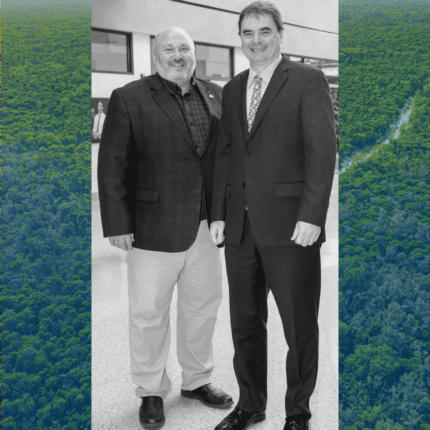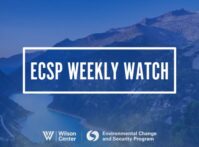-
Thought-leaders and Frontline Workers in Environmental Peacebuilding | An Oral History: Dr. Ken Conca and Dr. Geoff Dabelko
March 19, 2024 By Wilson Center StaffOn today’s episode of New Security Broadcast, ECSP and the Environmental Peacebuilding Association launch a series of oral history interviews with academics, practitioners, and frontline workers to trace the history of the field of environmental peacebuilding.
On today’s episode of New Security Broadcast, ECSP and the Environmental Peacebuilding Association launch a series of oral history interviews with academics, practitioners, and frontline workers to trace the history of the field of environmental peacebuilding. From the people who helped shape the field to those who are bringing new approaches and perspectives today, our guests give us a behind-the-scenes look at how the field first emerged and how it has evolved.
From the people who helped shape the field to those who are bringing new approaches and perspectives today, our guests give us a behind-the-scenes look at how the field first emerged and how it has evolved. The series delves into their stories and their leadership in framing and developing the field’s key concepts, elevating the understanding that a common concern for the environment can be a foundation to build peace, and practicing environmental peacebuilding on the frontlines.
In this first episode, ECSP’s Claire Doyle speaks with two of the earliest pioneers in the environmental peacebuilding field, Dr. Ken Conca and Dr. Geoff Dabelko. Dr. Conca is a professor of global environmental governance at the School of International Service at American University, and as a director on the board of the Environmental Peacebuilding Association. Dr. Dabelko is a Professor of Environmental Studies at Ohio University’s Voinovich School of Leadership and Public Service and a senior advisor for ECSP, where he was the Director from 1997 to 2012.
Ken and Geoff unpack what motivated them to publish their book “Environmental Peacemaking” and share how they’ve seen the field change, as well as their hopes for the future of environmental peacebuilding. Select quotes from the interview are featured below.
On the emergence of the environmental peacebuilding field in the 1990s
Geoff: In the mid-90s, the focus in the environmental security space was most heavily on this question of “do scarcity of resources and the environment drive or contribute to conflict?” That was an interesting set of questions, but ended up being fairly limited. That was the origin for the interest in flipping it on its head and saying: Can this set of issues where we have long-term interdependencies around resources and communities, countries, and regions be a source for building trust and ultimately, and ambitiously, peace?
Ken: In the early post-Cold War period, there was this really interesting intellectual fermentation of looking around for new sources of conflict and new characteristics of the international system. The environment emerged as a really interesting focal point in that. But I think we were very dissatisfied with the framework, the lens through which the environment was being seen; natural resource scarcity and environmental impacts lead to grievances, and grievances lead to conflict. So I think the reason we started working on the project that became the book “Environmental Peacemaking” was really just trying to stand that narrative on its head. The first chapter in that book is called The Case for Environmental Peacemaking.” And we really felt that an intellectual case had to be made that there were peaceful pathways out of our socio-ecological interdependencies.
On how the term “environmental peacebuilding” developed and how the field began to gain traction with the international community
Ken: I think the main driving force was that the UNEP was a small, weak agency that struggled in the context of the larger UN system to engage more influential groups like the UN Development Programme, or at the time, what was called the Department of Peacekeeping Operations. UNEP was seeking a certain kind of intellectual legitimacy for the policy advocacy work they were doing, which basically said you’ve got to get environmental protection and natural resource governance right, or you’re going to trigger new forms of conflict or slide back into the other forms of conflict.
Geoff: While we talked about the ways that environmental peacebuilding had prospects in prevention, during conflict, and after conflict, the politics and institutional structures at the UN initially only provided space to look into post-conflict. Member states wanted to avoid an avenue that might lead to any sort of rationale for intervention or that might tell them what they could or couldn’t do as sovereign states around natural resources for a prevention mission. And so, when the practitioners began saying, “tell me what to do,” then it became politically safe, and folks within the UN and UN Environment Program could operate. There was a focus on the peacebuilding commission in post-conflict settings because states were open to that. And there was much less willingness during conflict and prior to conflict. And so I think, in some ways, that gets to why “environmental peacebuilding” really became the go-to title for the umbrella of these various strands of research.
On how climate change became a mainstay in the field
Geoff: Climate change, starting in 2007, became the point of entry. As Ken says, this kind of 500-pound gorilla blocks out a lot of other topics that are connected to the field. And I think we are seeing progress as folks are trying to bring climate change down into specific contexts and what it means within different natural resources and environmental areas. Then there is a kind of opportunity for convergence. But 2007 was significant because it was the first time that the Security Council looked at any environmental issue.
I do think that now, the really interesting work that’s happening is that as we’re making investments in adaptation, poverty alleviation, and peacebuilding, and the kind of peace and conflict issues, are there ways that those can be done well? And then this other notion that we’ve raised in the last, say, 10 years: How do we make sure as we do well-intentioned climate responses that we’re not also locking in some of those inequalities and contributing to ongoing or creating new conflicts? And doing that in a way that is not climate-spurring backdraft dynamics, or rather, so that we are ensuring a just and peaceful transition as we address the climate challenges.
On how else the field of environmental peacebuilding has evolved
Ken: One of the most important things that’s happened is the creation of the Environmental Peacebuilding Association because it really doubles down on bringing a broad and diverse array of voices into the space. It’s really interesting to trace the history of the way that gender intersects with concerns about the relationship between the environment on the one hand and peace and conflict on the other.
There’s been a lot of positive possibilities to see an organization like EnPax with half of the membership, if not more, being people who are in the space of practice, whether they’re attached to civil society organizations or advocacy groups, or government agencies or intergovernmental organizations. That’s critically important. Evolution has been slow, it’s been imperfect, and there are still a lot of power dynamics at work in the field that make it easier for some people to get space and attention than others. And we need to be rigorously attentive to that going forward. But when you compare it to 25 years ago, it’s quite extraordinary.
On their hopes for the future of environmental peacebuilding
Ken: I worry that the very growing policy salience of the field, particularly around climate security, as you dubbed it earlier, contains a lot of peril for the field. We can’t have our field reduced to managing the ecological consequences of the insecurities of our current global security order and our current global economic order. So I would just end with a plea that people keep that idea of the need for solutions to be system-transformative rather than the band-aid approach? Because I think there’s going to be a lot of interest in band aids.
Geoff: My hope is that in the future, we will continue to have that broader view, that critical eye—that let’s not just take as a given the current landscape and look for these innovative ways that kind of have the same approach of, hey, let’s turn this relationship on its head and ask about peace and not just about conflict, and do that in ways where environment, natural resources, and climate are front and center.
Photo Credit: (Headshots) Ken Conca and Geoff Dabelko, (Background) Sundarban, in Bangladesh, the biggest mangrove forest in the world, courtesy of Mahmud Alam/Shutterstock.com
 A Publication of the Stimson Center.
A Publication of the Stimson Center.







